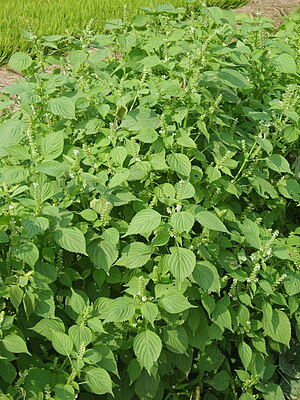Note: This is a project under development. The articles on this wiki are just being initiated and broadly incomplete. You can Help creating new pages.
Difference between revisions of "Perilla frutescens - Perilla"
(→Photo Gallery) |
(→Photo Gallery) |
||
| Line 45: | Line 45: | ||
==Photo Gallery== | ==Photo Gallery== | ||
<gallery class="left" caption="" widths="140px" heights="140px"> | <gallery class="left" caption="" widths="140px" heights="140px"> | ||
| − | + | File:Odermennig.jpg | |
| − | + | File:Agrimonia eupatoria02.jpg | |
| − | + | Image:Agrimonia eupatoria MHNT.BOT.2004.0.jpg | |
| − | |||
| − | |||
| − | |||
| − | |||
| − | |||
| − | |||
| − | |||
</gallery> | </gallery> | ||
Revision as of 18:24, 19 April 2018
Deulkkae is an annual plant native to Southeast Asia and Indian highlands, and grown in Korean peninsula, Southern China and India. The plant was introduced into Korea before Unified Silla era, when it was widely cultivated.
Contents
Uses
Wounds, Cuts, Snakebites, Curing liver disorders, Skin eruptions, Blotches, Pimples, Diarrhea, Sore throats[1]
Parts Used
Chemical Composition
Research has isolated such constituents as apigenin, Ascorbic-acid, beta-carotene, caffeic-acid, citral, dillapiol, elemicin, limonene, luteolin, myristicin, perillaldehyde, protocatechuic-acid, quercetin, rosmarinic-acid[2]
Common names
| Language | Common name |
|---|---|
| Kannada | |
| Hindi | |
| Malayalam | |
| Tamil | |
| Telugu | |
| Marathi | NA |
| Gujarathi | NA |
| Punjabi | NA |
| Kashmiri | NA |
| Sanskrit | |
| English | Agrimony |
Habit
Identification
Leaf
| Kind | Shape | Feature |
|---|---|---|
| Simple | opposite | 7–12 centimetres (2.8–4.7 in) long and 5–8 centimetres (2.0–3.1 in) wide, with an broad oval shape, pointy ends, serrated(saw-toothed) margins, and long leafstalks |
Flower
| Type | Size | Color and composition | Stamen | More information |
|---|---|---|---|---|
| Unisexual | The calyx, 3–4 millimetres (0.12–0.16 in) long | Yellow | four stamens | The flowers bloom on racemes at the end of branches and the main stalk in August and September |
Fruit
| Type | Size | Mass | Appearance | Seeds | More information |
|---|---|---|---|---|---|
| 7–10 mm (0.28–0.4 in.) long pome | clearly grooved lengthwise, Lowest hooked hairs aligned towards crown | With hooked hairs | {{{6}}} |
Other features
List of Ayurvedic medicine in which the herb is used
- Vishatinduka Taila as root juice extract
Where to get the saplings
Mode of Propagation
How to plant/cultivate
The plant was introduced into Korea before the Unified Silla era, when it started to be widely cultivated.In its natural state, the yield of perilla is not high. If the stem is cut about 5 centimetres (2.0 in) above ground level in summer, a new stalk grows and it produces more fruit. Leaves can be harvested from the stem cut off in the summer, as well as from the new stalk and its branches, throughout summer and autumn. The seeds are harvested in autumn when the fruits are ripe[4]
Commonly seen growing in areas
Pastures and fields, dry woods, along roadsides.
Photo Gallery
References
- ↑ Cite error: Invalid
<ref>tag; no text was provided for refs namedUses - ↑ "alternative nature herb"
- ↑ Cite error: Invalid
<ref>tag; no text was provided for refs namedLeaf - ↑ "wikipedea"
External Links
- Pages with reference errors
- Ayurvedic Herbs known to be helpful to treat Wounds
- Ayurvedic Herbs known to be helpful to treat Cuts
- Ayurvedic Herbs known to be helpful to treat Snakebites
- Ayurvedic Herbs known to be helpful to treat Curing liver disorders
- Ayurvedic Herbs known to be helpful to treat Skin eruptions
- Ayurvedic Herbs known to be helpful to treat Blotches
- Ayurvedic Herbs known to be helpful to treat Pimples
- Ayurvedic Herbs known to be helpful to treat Diarrhea
- Ayurvedic Herbs known to be helpful to treat Sore throats
- Herbs with Dried Folaige used in medicine
- Herbs with Whole herb used in medicine
- Herbs with common name in English
- Habit - perennial plant
- Index of Plants which can be propagated by Seeds
- Index of Plants which can be propagated by Cuttings
- Herbs that are commonly seen in the region of Pastures and fields
- Herbs that are commonly seen in the region of dry woods
- Herbs that are commonly seen in the region of along roadsides
- Herbs



